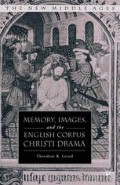Abstract
In his Metamorphoses Ovid mentions Mnemosyne only once, in the context of Arachne’s weaving in which she depicts, in competition with Athena, a number of Zeus’ indiscretions with women mortal and immortal: Zeus had taken Mnemosyne in the form of a humble shepherd.1 Arachne is changed into a spider for her trouble, but the image of Mnemosyne, or Memory, as the mother of the Muses was a classical commonplace. Apparently there is justice in, and mythological precedent for, Mary Carruthers’ statement that “all art, at some basic level, must engage the procedures of human memory…”2 The fullest classical account of the Mnemosyne’s bearing of the Muses can be found in the Theogony of Hesiod, where Zeus presents himself in Helicon to Mnemosyne, queen of the Eleutherian hills, as a shepherd taught by the Olympians. Zeus lies with her nine nights, and the nine Muses she bears combine civic and aesthetic virtues. Calliope, the Muse of epic poetry (one of the only two Muses mentioned by name in Ovid), is presented as having the highest standing, and her particular virtue is to smile on the just leader:
it is she who attends on the respected barons…
upon his speech, they make a distillation of sweetness3
Access this chapter
Tax calculation will be finalised at checkout
Purchases are for personal use only
Preview
Unable to display preview. Download preview PDF.
Notes
Ovid, Metamorphoses VI.114, ed. and trans. Frank Justus Miller, Loeb Classical Library (London: William Heinemann, 1916, repr. 1984), p. 296.
Mary J. Carruthers, The Craft of Thought (Cambridge: Cambridge University Press, 1998), p. 67.
Hesiod, Theogony trans. Richmond Lattimore (Ann Arbor, MI: University of Michigan Press, 1959, repr. 1978), p. 127.
Plato, Phaedrus and Letters VII & VIII, ed. and trans. Walter Hamilton (Middlesex, England: Penguin Books, 1973), p. 96.
Daniel Schacter, Searching for Memory (New York: BasicBooks, 1996), p.vii.
Gail McMurray Gibson, The Theater of Devotion (Chicago: University of Chicago Press, 1989), p. 114.
Carruthers, The Book of Memory (Cambridge: Cambridge University Press, 1990), pp. 221–57.
Copyright information
© 2008 Theodore K. Lerud
About this chapter
Cite this chapter
Lerud, T.K. (2008). Introduction. In: Memory, Images, and the English Corpus Christi Drama. The New Middle Ages. Palgrave Macmillan, New York. https://doi.org/10.1057/9780230613799_1
Download citation
DOI: https://doi.org/10.1057/9780230613799_1
Publisher Name: Palgrave Macmillan, New York
Print ISBN: 978-1-349-60290-2
Online ISBN: 978-0-230-61379-9
eBook Packages: Palgrave Political & Intern. Studies CollectionPolitical Science and International Studies (R0)

